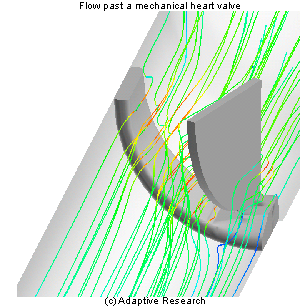CFD2000de Adaptive Research
CFD2000 es un avanzado sistema de dinámica de fluídos computacional (CFD), de propósito general, que permite la simulación de un amplio rango de problemas sobre flujo de fluídos y transferencia de calor y masa.
 CFD2000 is an advanced, general-purpose computational fluid dynamics (CFD)
software system for simulating a wide range of fluid flow and heat and mass
transfer problems including: CFD2000 is an advanced, general-purpose computational fluid dynamics (CFD)
software system for simulating a wide range of fluid flow and heat and mass
transfer problems including:
- Subsonic, transonic, and supersonic
- Chemical reaction
- Chemical vapor deposition
- Multi-phase flow
- Turbulence modeling
- Compressible / incompressible
- Conjugate heat transfer
- Radiation
- Free surface
- Fluid-Structure interaction
- Fire simulations
The CFD2000 system is exceptionally easy to learn/use, and can be quickly
mastered by scientists and engineers. CFD2000 is accessed with a state-of-the-art
Graphical User Interface (GUI) which provides full control of all the program?s
functions. The GUI menu structure represents a logical progression through the
process of fluid flow simulation that is intuitive for experienced CFD
investigators and a convenient guide for beginners.
Based on an advanced 3D windowing scheme, CFD2000?s intelligent GUI guides
you through all steps of a flow simulation. Using pull-down menus and a
combination of mouse and keyboard inputs, you can define the flow model, control
and monitor the progress of the analysis, and examine the results. The software
provides intelligent default values and performs extensive error checking on
inputs.
Features
General
- Fully interactive menu-driven input
- Multiple window environment
- Mesh-independent geometry
- Automatic mesh generation
- Point-and-click boundary condition specification
- Units conversion
- Flow field initialization tools
- Automatic time-stepping
- Mesh sequencing
- Real-time solution convergence monitoring
- Prompt line help
- Error diagnostics
- File management
Geometry Model Definition
- Coordinate systems, all with 1-, 2-, or 3-dimensions
- Cartesian coordinates
- Cylindrical coordinates (including 2D-axisymmetric)
- Body-fitted coordinates (BFC)
- Geometry-based modeling with separate specification for each region of
- Physical extent
- Number of computational elements (cells)
- Mesh stretching (power-law for Cartesian and cylindrical, hyperbolic for
BFC)
- Moving mesh capability
- CAD data import (IGES)
Analysis Options
- Steady-state or transient
- Incompressible low-speed or compressible transonic/supersonic flow
- Laminar or turbulent flow
- Flow through porous media
- Two-phase (particle/continuum) flow - Lagrangian particle tracking with
models for
- Particle breakup
- Particle merging
- Particle evaporation/ablation with latent heat exchange
- Free-Surface
- Chemically-reacting flow with fast chemical options
- Instantaneous
- Equilibrium
- Frozen
- Finite rate - multi-step
- Surface
- Chemical vapor deposition (CVD)
- Heat transfer
- Conjugate (fluid/solid) heat transfer
- Radiation (view factor method in BFC)
- Rigid body fluid-structure interaction (FSI)
- User-defined variables (chemical species/passive tracer concentrations)
- Full dependent variable control (store/save/print/omit options)
Fluid/Solid Property Control
Values drawn from built-in library, user-defined models, or specified as
constants
- Density (equation of state)
- Laminar viscosity, including three non-Newtonian extensions
- Power-law model
- Carreau model
- Bingham model
- Turbulent viscosity (k-epsilon model default)
- Specific heat
- Thermal conductivity
- Reference temperature and thermal expansion coefficient
- Mass diffusivities
Boundary Conditions
- Boundary conditions aligned to geometric regions or cells (independent
of computational mesh)
- User-supplied or model-generated name for each boundary
- "Point-and-click" boundary specification for
- Inlets, with velocities specified in terms of Cartesian coord
- Outlets, with external dependent variables
- Walls, with assigned fluxes/values for solved dependent var
- Volumetric blockages, with dependent variable flux/value assigned to each
surface
- General source quantities specified per unit volume, unit area, or per
cell
- Porous flow regions, with user-specifed permeability and nonlinear loss
coefficient
- Moving grid, with motion specified in terms of constant or time-dependent
velocities
- Gravity forces and other body forces, with force vector for each relevant
axis
- Cyclic boundaries in three orthogonal coordinate directions
- Boussinesq approximation available for buoyant convection
- Particle injection available at any boundary
Solution Control
- Initial values of all solved dependent variables can be set for the
entire domain or for domain subsets
- Restart capability for all solved dependent variables
- Automatic or specified time step control
- Separate time step multipliers for all transient variables
- Grid sequencing for automatic increase/decrease in grid resolution
- Choice of linear equation solvers for each dependent variable
- Alternating-direction implicit (ADI)
- Direct solver
- Incomplete factorization
- User control over number of iterations, relaxation factor, and
convergence criteria
- Four convection schemes available for each dependent variable
- 1st-order upwind
- 2nd-order upwind
- 3rd-order upwind
- Hybrid
- Two treatments available for diffusivity of each dependent variable
- Arithmetic averaging
- Harmonic averaging
- Toggle on/off compressibility and pressure work terms
- Run time solution monitoring
- Post-processing visualization output options
- Fieldview
- Tecplot
- Plot3D
|

